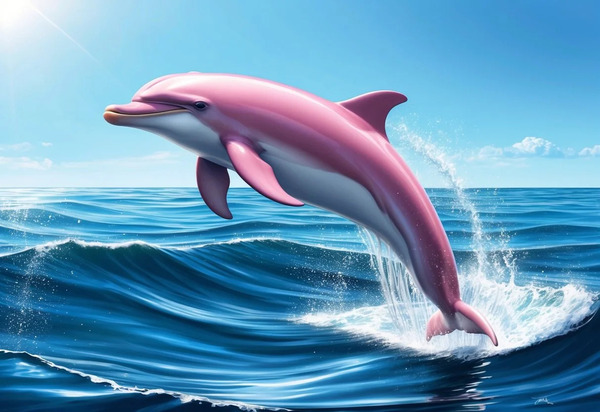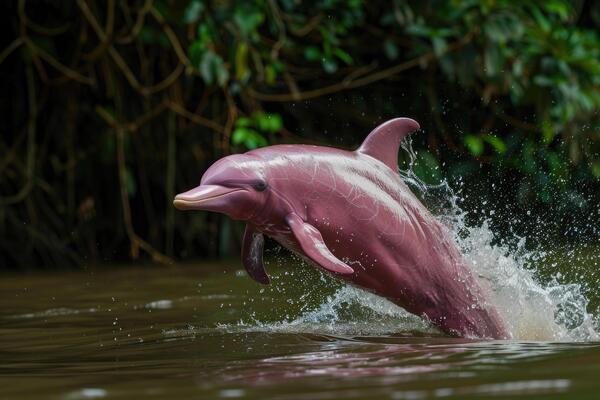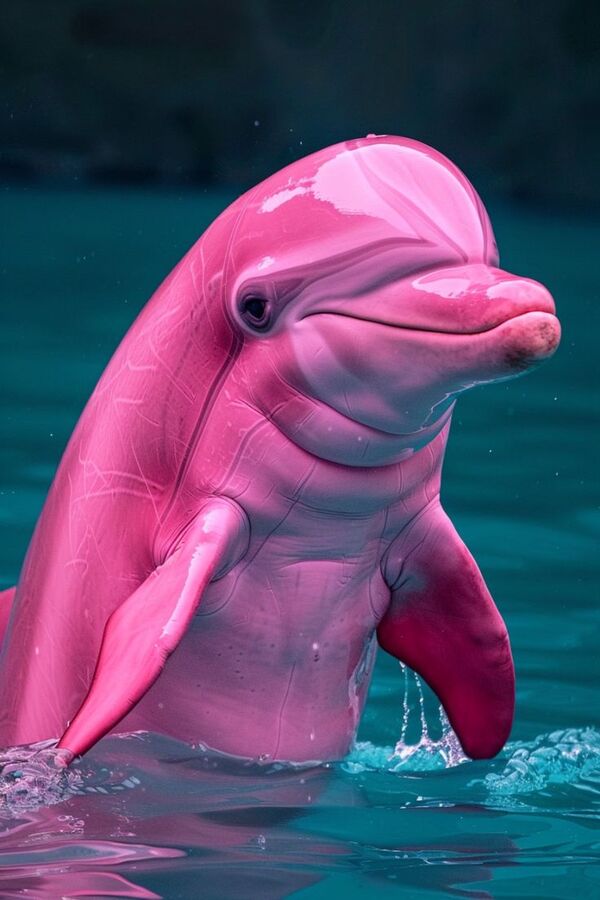Pink dolphins, also known as boto or Amazon river dolphins, are among the most unique and intriguing marine mammals in the world. With their distinctive pink coloration and playful behavior, these dolphins have captured the imagination of people everywhere. Here’s a comprehensive look at these remarkable creatures.

Pink dolphins can be recognized by their striking pink skin, which can vary in shade from light pink to a deeper hue. The coloration tends to be more pronounced in mature males, while younger dolphins and females may appear gray. They can grow up to 2.5 to 3 meters (approximately 8 to 10 feet) long and weigh between 100 to 200 kilograms (around 220 to 440 pounds).
Pink dolphins, particularly the Amazon river dolphins (boto), have a distinctive pink coloration that can vary from light to bright pink. Here are a few reasons why they are pink:
The pink coloration is primarily due to genetics. As these dolphins mature, their skin can change color, often becoming pinker in males. This change is linked to the presence of blood vessels near the surface of their skin.
The pink skin helps with thermoregulation. In warmer waters, the increased blood flow to the skin can cause the dolphins to appear more pink, as their bodies work to maintain a stable internal temperature.
The brightness of their coloration may play a role in social interactions. Males with more vibrant colors might be more attractive to females, signaling good health and genetic fitness.
The environment in which these dolphins live can influence their coloration. For example, exposure to sunlight and the clarity of the water can affect how pink they appear.
The pink coloration of dolphins is a fascinating adaptation influenced by genetics, health, and environmental factors. This unique trait not only makes them visually striking but also plays a role in their social interactions and survival in the wild.

Dolphins communicate using a variety of sounds, including clicks, whistles, and body language. Here’s a brief overview of their communication methods:
Clicks: Dolphins use clicks primarily for echolocation, helping them navigate and hunt for prey. The clicks can also serve as a form of communication, conveying information about their surroundings.
Whistles: Each dolphin has a unique signature whistle, which acts like a name. Dolphins use these whistles to identify themselves and communicate with others in their pod.
Body Language: Dolphins also communicate through physical gestures, such as leaping, spinning, or rubbing against one another. This non-verbal communication can express emotions and social interactions.
Postures and Facial Expressions: Dolphins use their body positions and facial features to convey feelings, such as aggression or playfulness.
Overall, dolphin communication is complex and plays a crucial role in their social interactions and survival.
Pink dolphins are primarily found in the freshwater rivers and lakes of the Amazon Basin in South America. Their range extends through countries like:
Brazil
Peru
Colombia
Venezuela
They inhabit the slow-moving waters of the Amazon River, its tributaries, and the flooded forests during the rainy season.
Estimating the exact population of pink dolphins is challenging due to their elusive nature and the vastness of their habitat. However, it is believed that there are between 10,000 to 100,000 pink dolphins in the wild. Despite their numbers, local populations can vary widely based on environmental conditions and human impacts.
Pink dolphins, particularly the Amazon river dolphins (boto), are generally not considered dangerous to humans. Here are some key points to understand their nature:
Pink dolphins are known for their playful and curious behavior. They are social animals that often swim in groups and exhibit friendly interactions with one another.
There are very few, if any, recorded instances of pink dolphins attacking humans. They tend to avoid human contact and are more likely to swim away if approached.
While pink dolphins are not aggressive, they can display defensive behavior if they feel threatened, particularly when protecting their young. Like many wild animals, they may react if they perceive a threat.
Some local legends portray pink dolphins as mystical beings, leading to both fascination and fear in certain cultures. However, these stories often exaggerate their nature
Overall, pink dolphins are not dangerous to humans. They are gentle creatures that play an important role in their ecosystem. Respecting their natural habitat and keeping a safe distance when observing them is the best way to ensure peaceful interactions.

Pink dolphins, particularly the Amazon river dolphins (boto), face a few natural predators and have varying populations across different countries. Here’s a table summarizing their predators, existing populations, and distribution by country:
| Country | Population Estimate | Region | Predators |
|---|---|---|---|
| Brazil | 10,000 - 50,000 | Amazon River and tributaries | Jaguars, caimans |
| Peru | 5,000 - 15,000 | Amazon Basin | Jaguars, large fish |
| Colombia | 2,000 - 10,000 | Amazon River and surrounding areas | Caiman, large predatory fish |
| Venezuela | 1,000 - 5,000 | Orinoco River and tributaries | Caimans, jaguars |
| Ecuador | 500 - 3,000 | Amazon region | Caimans, large predatory fish |
Predators: Pink dolphins face threats primarily from jaguars and caimans, which are natural predators in their habitats. Large predatory fish can also pose a threat, particularly to younger dolphins.
Population Estimates: Population numbers can vary widely due to environmental factors, human activity, and the challenges of monitoring these elusive creatures. The estimates provided are rough approximations.
Distribution: Pink dolphins are mainly found in freshwater rivers and lakes within the Amazon Basin, with significant populations in Brazil, Peru, Colombia, Venezuela, and Ecuador.
This table provides a snapshot of the existing populations of pink dolphins and highlights some of their natural predators in the wild.
The IUCN (International Union for Conservation of Nature) lists pink dolphins as Data Deficient, meaning that there is insufficient data to determine their overall risk of extinction. However, they face several threats, including:
Habitat Loss: Deforestation and the construction of dams in the Amazon River disrupt their natural habitats.
Pollution: Industrial runoff and agricultural chemicals can contaminate their waters, affecting their health and food sources.
Fishing Nets: Pink dolphins can become entangled in fishing gear, leading to injury or death.
Conserving pink dolphins is crucial not only for their survival but also for maintaining the health of the Amazon ecosystem. They play a significant role in controlling fish populations and contributing to the overall balance of their habitat.
In many Amazonian cultures, pink dolphins are seen as mystical creatures. Local legends often describe them as shape-shifters or protectors of the river. This cultural significance can help in conservation efforts, as communities that value these dolphins may be more inclined to protect them.
Pink dolphins are remarkable creatures that highlight the biodiversity of the Amazon River and its importance to global ecosystems. While they face several threats, understanding and protecting their habitats can help ensure their survival for future generations. With continued awareness and conservation efforts, we can hope to preserve these enchanting animals and the rich environments they inhabit.

While both the pink dolphin and the pink porpoise may sound similar, they are distinct species with different characteristics. Here’s a comparison of the two:
| Feature | Pink Dolphin (Amazon River Dolphin) | Pink Porpoise (often refers to the Vaquita) |
|---|---|---|
| Scientific Name | Inia geoffrensis | Phocoena sinus (Vaquita) |
| Habitat | Freshwater rivers in the Amazon Basin | Coastal waters of the northern Gulf of California |
| Coloration | Generally pink, especially in males; can vary from gray to pink | Typically gray, with darker pigmentation; Vaquitas may appear lighter in some cases |
| Size | Up to 2.5 - 3 meters (8 - 10 feet) | Up to 1.5 meters (5 feet) for Vaquitas |
| Social Behavior | Social, often found in groups | Generally more solitary; less social behavior |
| Diet | Fish, crustaceans, and aquatic invertebrates | Fish, primarily small schooling fish |
| Conservation Status | Data Deficient (IUCN) | Critically Endangered (IUCN) |
| Population Estimate | 10,000 - 50,000 | Fewer than 30 individuals remaining |
Species and Classification:
Pink dolphins are part of the river dolphin family, while pink porpoises, specifically referring to the Vaquita, are part of the porpoise family.
Habitat:
Pink dolphins thrive in freshwater environments, specifically in the Amazon River and its tributaries. In contrast, pink porpoises inhabit coastal marine environments.
Appearance:
Pink dolphins exhibit a notable pink color, especially in males, while pink porpoises (Vaquitas) are generally gray and may not display a distinct pink coloration.
Conservation Status:
Pink dolphins are listed as Data Deficient, while pink porpoises (Vaquitas) are critically endangered, with urgent conservation efforts needed to protect their dwindling population.
Both the pink dolphin and the pink porpoise (Vaquita) are fascinating marine mammals, but they differ significantly in terms of habitat, appearance, behavior, and conservation status. Understanding these differences is essential for their conservation and the protection of their ecosystems.
animal tags: pink-dolphin
We created this article in conjunction with AI technology, then made sure it was fact-checked and edited by a Animals Top editor.